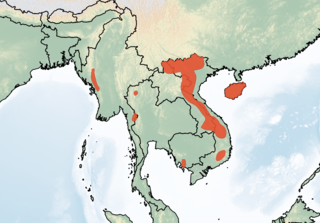
The Chao Phraya is the major river in Thailand, with its low alluvial plain forming the centre of the country. It flows through Bangkok and then into the Gulf of Thailand.

The Laotian rock rat or kha-nyou, sometimes called the "rat-squirrel", is a species of rodent found in the Khammouan region of Laos. The species was first described in a 2005 article by Paulina Jenkins and coauthors, who considered the animal to be so distinct from all living rodents, they placed it in a new family, Laonastidae. It is in the monotypic genus Laonastes.

The Chao Phraya freshwater swamp forests is a tropical and subtropical moist broadleaf forests ecoregion in Thailand. It occupies the lowlands of the Chao Phraya River watershed in central Thailand. The ecoregion was once home to extensive swamp forests and wetlands. The ecoregion has mostly been converted to agriculture and cities, and very little natural forest remains. The ecoregion's rice paddies and waterways still sustain some wildlife.
The long-headed hill rat is a species of rodent in the family Muridae. It is found only in Sulawesi, Indonesia, where it is only known from Mount Tambusisi. Its natural habitat is subtropical or tropical dry forests. It is threatened by habitat loss.

The marmoset rat, also known as the greater marmoset rat, is a species of rodent in the family Muridae. It is found in Malaysia, Myanmar, and Thailand. Its natural habitat is subtropical or tropical dry forests. It is threatened by habitat loss.
The Komodo rat or Nusa Tenggara Komodomys, is a species of rodent in the family Muridae found only in the Lesser Sunda Islands of Indonesia, in Rintja, Padar, Lomblen, and Pantar islands. Its natural habitat is subtropical or tropical dry forests. It is threatened by habitat loss.

Edwards's long-tailed giant rat is a species of rodent in the family Muridae. It is found in China, India, Indonesia, Laos, Malaysia, Burma, Thailand, and Vietnam.

Leopoldamys is a genus of rodents in the family Muridae endemic to Southeast Asia. It contains the following species:

The long-tailed giant rat is a species of rodent in the family Muridae. It is found in Bangladesh, Cambodia, Indonesia, Laos, Malaysia, Thailand, and Vietnam.
The Mentawai long-tailed giant rat is a species of rodent in the family Muridae. It is endemic to the Mentawai Islands archipelago off the west coast of Sumatra, in Indonesia. Its natural habitat is subtropical or tropical dry forest. It is threatened by habitat loss.

The dark-tailed tree rat or Sundaic arboreal niviventer is a species of rodent in the family Muridae. It is found on the Malay Peninsula, including some offshore islands, and in parts of the Malay Archipelago. It might be a species complex.

The limestone rat is a species of rodent in the family Muridae found only in the limestone karsts of Saraburi, Lopburi, Nakhon Sawan provinces, central Thailand. It is listed as an endangered species due to its highly fragmented limestone karst habitat that is currently threatened by mining.

The Tenasserim white-bellied rat is a species of rodent in the family Muridae. It is named after the Tenasserim Hills and is found above 1,000 m in forested limestone mountainous areas. Its distribution includes India, Myanmar, Thailand, Cambodia (southern end of the Cardamom Mountains, Laos and Vietnam, and China.

The Malayan field rat, Malaysian field rat or Malaysian wood rat, is a species of rodent in the family Muridae. It is nocturnal and mainly arboreal and is found in Malaysia, Thailand, Indonesia and the Philippines. It is a common species and the International Union for Conservation of Nature has assessed it as being of "least concern".

The bare-faced bulbul is a member of the bulbul family of passerine birds. It was newly described from central Laos in 2009. It is one of the very few Asian songbirds with a bald (featherless) face and is the first new species of bulbul to be described from Asia in almost a century.
Daovantien’s limestone rat is a genus of Muridae rodent native to northeastern Vietnam. It was first discovered in a forested talus habitat in the Huu Lien Nature Reserve, Lang Son Province. It is the only known species in the genus Tonkinomys.

Saxatilomys paulinae is a species of murid rodent native to central Laos and Vietnam, separated to a monotypic genus Saxatilomys. It was first discovered in the Khammouan Limestone National Biodiversity Conservation Area in Khammouan Province, Laos, and also been found in the Vietnamese province of Quang Bình. It is the only known species in the genus Saxatilomys. The genus name is derived from the Latin saxatilis, meaning "among the rocks" and the Greek mys, meaning mouse or rat.
The Sundaic mountain leopoldamys is a species of rodent from the family Muridae. It was formerly considered a subspecies of Edwards's long-tailed giant rat, and it has one synonym: Leopoldamys setiger.
Millet's leopoldamys is a species of rodent from the family Muridae. It lives in the Langbian highlands of southern Vietnam, although its distribution limits are currently unresolved. It is listed as Least Concern on the IUCN Red List, and though only a handful of museum specimens signify its existence, it is presumed to have a high, stable population. There are no apparent major threats to the species, and it occurs in a number of protected Vietnamese areas. Millet's leopoldamys is a large, terrestrial omnivore that prefers montane forest, but is tolerant of secondary forest.

Pendlebury's roundleaf bat is a species of bat in the family Hipposideridae. It was previously considered a subspecies of H. turpis, but has now been raised to full species level. It is endemic to Thailand and is found in limestone karst areas.














